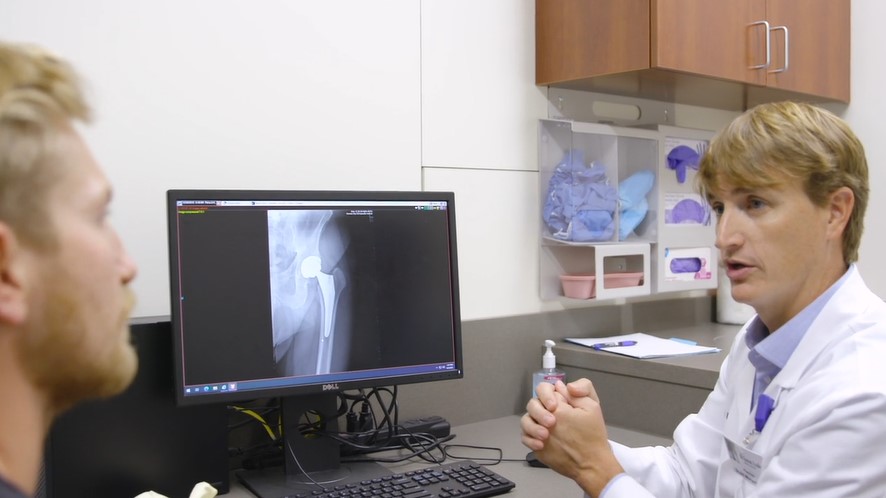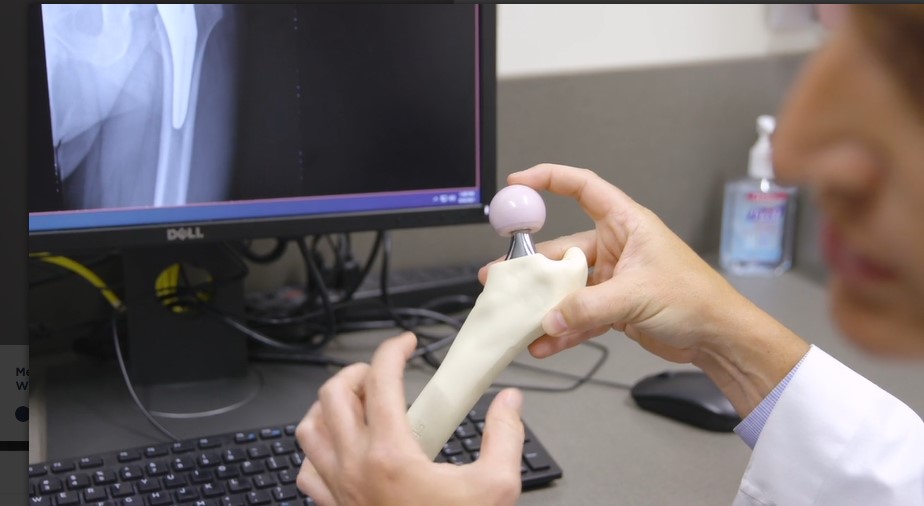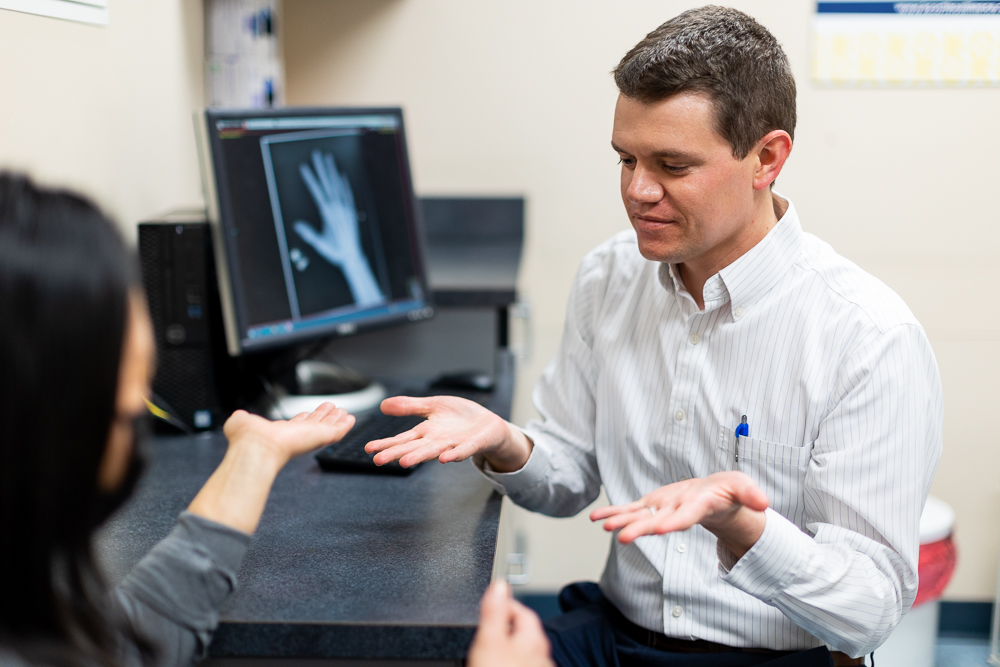
Understanding Hip Osteoarthritis: When is Joint Replacement the Answer?
That nagging ache deep in your hip, the morning stiffness that feels like your joint is locked in place, the increasing difficulty with everyday activities you once took for granted – these could be telltale signs of osteoarthritis (OA), a prevalent condition affecting countless individuals. Here at Kansas City Orthopedic Alliance (KCOA), our dedicated team of orthopedic surgeons understands the profound impact hip pain can have on your quality of life.
This post will familiarize you with the symptoms of hip osteoarthritis and the various treatment pathways, while helping you understand when hip joint replacement surgery might be necessary.

What is Osteoarthritis of the Hip?
Osteoarthritis of the hip isn’t simply “wear and tear.” It’s a complex degenerative process within the joint. The hip joint, a ball-and-socket joint, relies on a smooth layer of cartilage covering the femoral head (the “ball” at the top of your thigh bone) and the acetabulum (the “socket” in your pelvis). This cartilage acts as a frictionless cushion, allowing for fluid and pain-free movement. In osteoarthritis, this protective cartilage gradually erodes and thins. As the cartilage deteriorates, the underlying bone becomes exposed. This bone-on-bone friction during movement leads to the hallmark symptoms of pain, inflammation and stiffness.
Over time, the joint can also develop bone spurs (osteophytes), which can further restrict movement and exacerbate pain. While age is a significant risk factor, it’s crucial to understand that OA isn’t an inevitable part of aging for everyone. Factors such as a family history of arthritis, previous hip injuries including a labral tear, developmental hip dysplasia, obesity (which puts increased stress on the joints) and repetitive high-impact activities can all increase your susceptibility to developing osteoarthritis in the hip.
Recognizing the Symptoms of Hip OA
The onset of hip osteoarthritis symptoms is often gradual, which can sometimes make it challenging to recognize the early stages. Paying attention to subtle changes in how your hip feels and functions is key. Beyond the core symptoms previously mentioned, here are some more nuanced ways hip OA can manifest:
- Night Pain: As the condition progresses, you may experience persistent hip pain even while resting, often disrupting your sleep.
- Referred Pain: The pain from hip OA can sometimes be felt in unexpected areas, such as the lower back, groin, or even down the front of the thigh towards the knee. This “referred pain” can sometimes make diagnosis tricky.
- Changes in Gait: You might notice yourself favoring one leg over the other, developing a more pronounced limp, or experiencing a Trendelenburg gait (where your pelvis drops on the side of the lifted leg due to weakness in the hip abductor muscles).
- Loss of Flexibility: You may find it increasingly difficult to perform actions that require hip flexion, extension, abduction (moving the leg away from the body), or rotation. Simple tasks like crossing your legs or bending to tie your shoes can become significant challenges.
- Swelling and Tenderness: In some cases, particularly during periods of increased activity or inflammation, you might experience mild swelling or tenderness around the hip joint.
- Crepitus: The grinding, clicking, or popping sound you hear (crepitus) can become more frequent and pronounced as the cartilage wears away and the bony surfaces roughen.

Exploring Treatment Options for Hip Osteoarthritis
The management of hip osteoarthritis typically begins with a comprehensive evaluation by an experienced orthopedic surgeon at KCOA. This evaluation will involve a thorough physical examination, a review of your medical history and symptoms, and diagnostic imaging such as X-rays. In some cases, MRI and/or CT scans may be used to provide more detailed information about the soft tissues around the hip, including ruling out other conditions like a labral tear.
Fortunately, there are various treatment options available for managing hip osteoarthritis. Initially, your orthopedic surgeon at KCOA will likely recommend conservative approaches, such as:
- Lifestyle Modifications: This can include weight management, low-impact exercises like swimming or cycling, and avoiding activities that aggravate your pain.
- Physical Therapy: Strengthening the muscles around your hip can help to stabilize the joint and reduce pain.
- Medications: Over-the-counter pain relievers like ibuprofen or naproxen, as well as prescription medications, can help manage pain and inflammation.
- Injections: Corticosteroid injections into the hip joint can provide temporary pain relief.
You can learn more about the comprehensive hip treatments offered at KCOA.
When is Joint Replacement Surgery Considered?
While conservative treatments can be effective in managing early to moderate hip osteoarthritis, there may come a point when these options no longer provide sufficient pain relief and improvement in function. Your orthopedic surgeon may then discuss hip joint replacement surgery as a potential solution.
Things to consider when determining if you are a candidate for hip replacement surgery:
- Severe Pain: You experience significant hip pain that interferes with your daily activities, sleep and overall quality of life.
- Limited Mobility: You have significant difficulty walking, climbing stairs, or performing basic movements despite trying other treatments.
- Lack of Improvement with Non-Surgical Options: Conservative treatments have been exhausted without providing substantial or lasting relief.
- X-ray Evidence of Advanced OA: Imaging studies clearly show significant damage to the hip joint.
- Your Personal Goals and Expectations: What are your goals for pain relief and improved function? A successful hip replacement can often allow individuals to return to activities they previously had to give up.
Hip replacement surgery involves replacing the damaged cartilage and bone in your hip joint with artificial components (prosthesis). This procedure can effectively relieve pain, improve mobility, and allow you to return to a more active lifestyle. The decision to undergo joint replacement surgery is a collaborative one between you and your experienced orthopedic surgeon at KCOA.
KCOA Surgeons Specializing in Hip Replacement
Dr. Scott Abraham, Dr. Cris Barnthouse, Dr. Sean Bonanni, Dr. John Carlisle, Dr. David Clymer, Dr. Scott Cook, Dr. Burrel Gaddy, Dr. Michael McCabe, Dr. Kirk McCullough, Dr. Christopher Peer, Dr. Dan Reinhardt, Dr. Robert Sharpe, Dr. Nick Ting and Dr. Scott Wingerter.
Living with chronic hip pain from osteoarthritis can significantly limit your enjoyment of life. Understanding the symptoms, exploring the range of treatment options, and knowing when joint replacement surgery might be the most effective solution are crucial steps in taking control of your health.
Don’t let hip pain control your life. If you’re experiencing symptoms of osteoarthritis and conservative treatments haven’t provided the relief you need, it may be time to explore other options.
Take the first step towards a more comfortable and active future. Request an appointment with one of our expert hip specialists at KCOA today.


